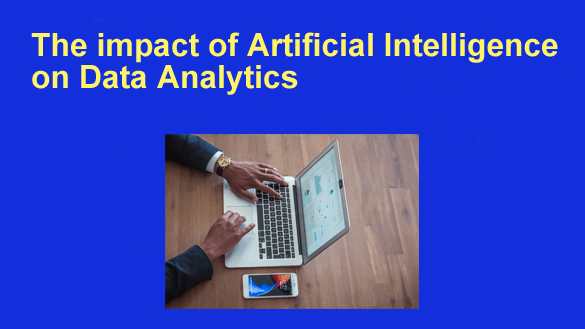 Artificial intelligence (AI) is no longer a futuristic concept; it is a driving force in today’s technological landscape, reshaping various industries and redefining how businesses operate. One of the most significant areas where AI is making an impact is data analytics.
Artificial intelligence (AI) is no longer a futuristic concept; it is a driving force in today’s technological landscape, reshaping various industries and redefining how businesses operate. One of the most significant areas where AI is making an impact is data analytics.
As organizations increasingly rely on data to make informed decisions, the incorporation of AI into data analytics processes has become increasingly crucial.
This article will explore key ways in which AI is transforming data analytics, providing insights into the current and future landscape of this critical field.
1 – AI-Driven Data Processing
One of the most profound impacts of AI on data analytics is its ability to process large volumes of data quickly and accurately. Traditional data processing methods often require significant time. However, AI-driven algorithms can analyze vast amounts of data in a fraction of the time, identifying patterns, correlations, and trends that might be missed by human analysts.
AI’s speed and precision in data processing are particularly beneficial for industries that rely on real-time data analysis, such as finance, healthcare, and retail. For example, in the financial sector, AI can quickly analyze market trends and trading patterns, enabling faster and more informed decision-making. The ability to handle complex datasets efficiently makes AI an invaluable tool in the data analytics process.
2 – Enhanced Learning Opportunities through AI
As AI continues to advance, it is also transforming the landscape of education, particularly in data analytics. With the growing demand for skilled data professionals, educational institutions are increasingly incorporating AI-driven tools and techniques into their curricula. This integration not only equips students with the latest knowledge but also prepares them to work with the cutting-edge technologies that are shaping the future of data analytics.
For those looking to enter or advance in the field, you can find data analytics courses online that offer specialized training that includes AI-driven methods. These courses provide hands-on experience with AI tools, allowing learners to develop the skills needed to analyze data more effectively. By enrolling in these programs, students can stay ahead of industry trends and gain a competitive edge in the job market. The inclusion of AI in data analytics education is essential for preparing the next generation of data professionals.
3 – Predictive Analytics with AI
Predictive analytics has become a cornerstone of data-driven decision-making, and AI is playing a crucial role in enhancing its accuracy and effectiveness. Traditional predictive models rely on historical data and statistical methods to forecast future trends. While these models can be effective, they often have limitations in handling complex data and identifying subtle patterns.
AI, on the other hand, excels at processing large datasets and detecting intricate patterns that may not be apparent through traditional methods. By using machine learning algorithms, AI can continuously improve its predictive accuracy over time. This capability is particularly valuable in industries such as marketing, finance, and healthcare, where accurate predictions can lead to better strategic decisions. For example, AI-driven predictive analytics can help businesses anticipate customer behavior, optimize marketing campaigns, and manage risk more effectively.
4 – Real-Time Data Analysis
In today’s fast-paced business environment, the ability to analyze data in real time is a significant advantage. Real-time data analysis allows organizations to respond quickly to changing conditions, make informed decisions on the fly, and stay ahead of the competition. AI is a key enabler of real-time data analysis, providing the computational power and algorithms needed to process and interpret data as it is generated.
For example, in the retail industry, AI-powered systems can analyze customer behavior in real time, allowing businesses to adjust pricing, promotions, and inventory on the spot. In manufacturing, real-time data analysis can help monitor equipment performance and predict maintenance needs, reducing downtime and improving efficiency. The ability to analyze data as it happens is transforming how businesses operate, making them more agile and responsive to market demands.
5 – AI in Data Visualization
Data visualization is a critical aspect of data analytics, as it allows complex data to be presented in a way that is easily understood by non-experts. AI is revolutionizing data visualization by making it more intuitive, interactive, and accessible. Traditional data visualization tools often require significant manual input to create charts, graphs, and dashboards. However, AI-driven tools can automatically generate visualizations based on the data, saving time and reducing the potential for human error.
AI also enhances data visualization by identifying the most relevant data points and patterns to highlight. This capability is particularly useful in scenarios where large datasets need to be quickly understood and acted upon. For instance, AI can create dynamic dashboards that update in real time, providing decision-makers with the most current insights at a glance. By making data more accessible and understandable, AI-driven data visualization tools are empowering organizations to make better decisions faster.
In conclusion, the integration of AI into data analytics is transforming the field in profound ways. From enhancing data processing and predictive analytics to revolutionizing real-time analysis and data visualization, AI is driving significant advancements that are reshaping how businesses leverage data. As AI continues to evolve, its impact on data analytics will only grow, making it essential for professionals to stay informed and adapt to these changes.